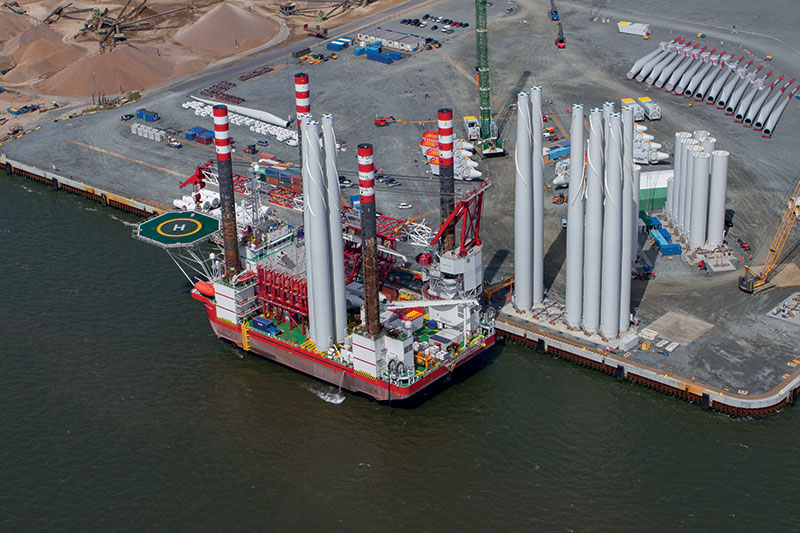Getting ready to redesign energy
Tracking the future
GETTING READY TO REDESIGN ENERGY

Energy market drivers are rapidly changing. How are new developments aff ecting demand, infrastructure, distribution, storage and sales?
Systems for generating, storing and transporting electrical power, initially developed in the nineteenth century, are ready for redesign. But which factors determine the changes that need to be made? First, some statistics: global population continues to expand, the average human lifespan is increasing and energy demand in non-OECD countries is rising. All of these factors are changing the way we need to generate, distribute and store power.
The US Energy Information Administration’s International Energy Outlook 2016 (IEO2016) predicts a 48% increase in worldwide energy demand from 2012 to 2040. Economic and population growth in developing non-OECD nations will result in a 71% increase in demand between 2012 and 2040. Half of the expected global energy consumption increase during the same period is expected to occur in non-OECD Asia, including fast-developing China and India. In OECD economies, energy usage is expected to grow by 18%. Global net electricity generation is predicted to rise 1.9% per year on average. As a result, the need may arise to transport energy to more regions than before, some of which are far from existing grids and routes.
“By 2050, we will be twice as rich as we are now, in terms of GDP, but we cannot aff ord to use twice the energy we use today,” says Hans Nieman, Senior Vice President Energy Products, Prysmian. “The amount of energy required for data processing is already greater than the energy consumed by air tra ffi c. This will only increase further. Furthermore, the diff usion of electric vehicles will exponentially increase electricity demand and infrastructure requirements. Globally, I see two key trends aff ecting the energy markets, which have far-reaching consequences for both power transport and communications cabling and hardware: decarbonisation and digitalization.”
Megatrend number one: Decarbonisation
Decarbonisation is, basically, diminished dependency on fossil fuels. Other sources of power have been around for some time, but new (technology) developments are making these sources more attractive thanks to greater yield and reliability. Improved power converter semiconductors and high-e ffi ciency graphene solar cells are just two examples. According to the US Energy Information Administration, hydropower and wind will account for two-thirds of the total increment in increased global electricity generation from 2012 to 2040, making them the two largest contributors. Hans Nieman states: “In the EU, for example, we have seen the mix of power generation sources shifting towards renewables and a decline of electricity generation from solid fuels and nuclear power. There have been signifi cant developments in renewable energy, mostly solar and wind onshore. Investments in new plants are dominated by renewable energy. Renewables are becoming competitive, notably solar photovoltaic technologies in southern Europe. Onshore wind is close to being competitive, with limited potential for additional cost reductions.” Higher-yield solar power could lead to homes that are not only self-su ffi cient, but also feed surplus energy into the electrical grid. Data collection and analysis will allow for optimisation of energy usage, making homes and business far more energy-e ffi cient. This means storage won’t be limited to a few vast facilities, but that power will be stored in enormous numbers of smaller batteries and transported across small distances. Energy used to be mainly generated in power stations and transported to local end users through a one-way system.
Megatrend number two: Digitalisation
Ongoing and ever-faster digitalisation is expected to optimise many aspects of power generation, storage and distribution. As buildings increasingly act as energy sources (albeit with relatively low and strongly varying yields) there will be increasing need to organise and scale power networks to fi t current needs. Measurement and distribution rely on real-time information, collected and analysed using smart metering and smart grid solutions. Integration of power and fi ber-optic data cabling is essential to supporting optimisation of energy usage, storage, transport and billing. Convergence of ICT solutions with in-building devices and systems, from lighting to heating, will further enhance e ffi ciency and help manage demand. Eventually, they will probably manage and optimise themselves. However, the introduction of more technology into power systems may potentially raise the risk of cyber attacks.

“Digitalisation enables data exchange in ways which were never before available, and bring users information in a more secure way,” Hans Nieman explains. “Cisco estimates the IoT will consist of 50 billion devices connected to the Internet by 2020. Gain deeper insight with analytics using our IoT System to enhance productivity, create new business models, and generate new revenue streams. Higher levels of interconnection level and increased possibilities for controlling and interacting mean there’s a stronger need for connected data in power networks.”
The hybrid power network of the near future will encompass everything from large power plants and long-distance regional power grids to energy-producing homes and o ffi ces connected by local micro grids. This will require large-scale grid modernisation to accommodate two-way fl ow of power and information, as well as integration of mobile devices and smart sensors.
Designing, building and maintaining networks today
What do current technological and societal developments mean for energy and data networks? How will they aff ect planning, building and maintenance?
For power and data networks, new and more aff ordable technologies are making design, inspection and maintenance easier and more effi cient. To give a few examples, Internet of Things-connected devices, Automated Infrastructure Management and remote inspection drones are all playing a part in this. On the software side, we see increasingly accurate predictive modelling improving design, rollouts and maintenance. These options must be taken into consideration from the outset.
Cloud, wireless and Internet of Things (IoT)
Looking at data networks, we see more applications and services migrating to the cloud, which has its consequences for WAN architecture. This is resulting in an increase in points-of-presence at colocation facilities. We’re also seeing more ‘edge data centres’, which position bandwidth-hungry content from HD video to autonomous car data closer to the end user in (usually) Tier 2 markets and further from traditional internet hubs.
Growing adoption of wireless across areas such as healthcare, entertainment, hospitality and retail, is playing a signifi cant part in boosting increased bandwidth demand. It is important to note that as speed and bandwidth increase, reach decreases, necessitating more Wireless Access Points (WAPs) to cover a given surface area.
IoT is becoming more widely adopted for everything from enhancing consumer device functionality to facilitating smart building infrastructure and management. Cisco Senior Vice President and General Manager Internet of Things (IoT) and Applications, Rowan Trollope, says that the internet will connect 20 billion devices by 2020. Vast and growing amounts of data generated by the IoT have to be processed, analysed, collated and stored. This requires a diff erent approach to cabling and networks.
To fully unleash the potential of IoT, many connected devices need to be powered to function as intended and to stay connected to the internet. However, growing, increasingly complex systems are spread across ever-larger geographical areas. A recent report from ABI Research states that IoT market growth depends on adoption of no cellular low-power wide-area networks (LPWANs) that can provide a solution for large, geographically dispersed networks. This, in turn, requires standardisation amongst vendors, stimulating the IoT ecosystem.
A commonly used, increasingly popular solution is Power over Ethernet (PoE), which combines energy and data transmission, allowing network devices to be powered using copper data cabling. The coming generation of PoE can provide 90 Watts, which means increased heat build-up, requiring additional cable management steps.
The power of data and increasingly intelligent networks
In the world of power networks, new customer expectations and developments in policy and technology are driving change. Two areas that currently stand out are data analytics and grid modernisation.
We’re seeing growing digitisation of electricity networks, with benefi ts such as enhanced visibility across the network and data-driven diagnosis and maintenance. Today’s integrated power management systems need to be interoperable, allowing the sharing of data between platforms, and they need to be easily scalable and fl exible with regard to functionality.
The availability of advanced, aff ordable sensors is making it possible for owners and managers of power utilities and assets to collect and analyse data to an extent previously unimaginable. The introduction of these devices as well as smart meters and the fact that more and more homes are capable of generating their own power and feeding it back into the grid have far-reaching consequences for network architecture. For one thing, maintenance will be more strongly based on the condition of hardware and not carried out according to a predetermined schedule.
With more renewable sources and more homes and business generating energy, the structure of electrical grids is also changing. Instead of centralised production and transport over a huge ‘macrogrid’, we’re seeing more microgrids, which group local power sourced. These can operate independently of large-area grids.
Sustainable systems for renewables

Choosing power and communications solutions for harsh environments.
Cabling and hardware intended for use in fast-growing renewable energy projects must offer the longest operational lifetime and the highest uptime. How to guarantee performance in harsh environments without compromising on functionality?
In 2015, power from renewable sources surpassed coal, becoming the world’s largest source of installed power capacity, reaching 153 Gigawatts – a 15% increase over the previous year. Last year, the International Energy Agency significantly increased its five-year growth forecast for renewables, based on policy support and cost reductions. The World Energy Council reported ‘explosive average annual growth’ of wind and solar power over the last decade – 23% and 50% respectively. As a result of yield and efficiency advances, hydroelectric power now provides almost a fifth of the world’s electricity. According to the US Geothermal Energy Association, geothermal power showed sustained strong growth last year, thanks to new policies and investment regimes.
Changing requirements
All such types of power infrastructure require energy and communications networks that can operate under the harshest conditions, in hard-to-reach locations. After all, solar power installations are often found in deserts and wind farms are frequently located offshore and along coastlines. Geothermal and hydroelectric power involves extreme forces, temperatures and chemical reactions. What’s more, these systems need to accommodate many different types of equipment. IP Convergence is bringing new types of sensors and controllers to the network. Rolling-out electrical cables all the way to network devices is expensive and time-consuming. However, Power over Ethernet (PoE) can supply current to network devices in very hard-to-reach places in a smart, relatively inexpensive way, providing power over a hundred meters or so to devices in hard-to-access locations.
Potential problems
Water ingress may cause return loss and insertion loss problems with communications cables and potentially extremely dangerous electrical and fire hazards with (high voltage) power cables. Chemicals such as sculpture, extreme temperatures or high salinity levels that may occur in geothermal applications can make cables brittle and rigid, and damage the protective sheathing. Mechanical stress is another frequent cause of damage. As cabling is generally packed tightly, movement or crushing can have a negative effect on performance.
Prolonged exposure to UV light can result in mechanical degradation of the sheath. Electromagnetic interference caused by, for example, electric motors, can induce noise or harmonic disturbances. Cable performance is also strongly affected by temperature. Extremely low temperatures, say below 10˚C, can lead to degradation of sheathing. Very high temperatures, for example over 60˚C, can result in insertion loss.
Why fibre?
More and more cables are being deployed for digital monitoring, control and safety systems in harsh environments. In these applications, fibre offers many advantages over copper cables such as resistance to electrical interference from other devices, elimination of the possibility of creating electrical shorts that could create fires or explosions, vastly increased data transmission rates and increased network security.
Copper cables may be somewhat more resistant to abuse during service and installation since optical fibre can only withstand a few percent bending or tensile strain before being permanently damaged. Copper instrumentation and equipment cables, however, can fail due to electrical shorts when the insulation breaks down. An optical fibre may continue to function even if the cable around it totally disintegrates as long as the fibre is not subjected to high-tensile or bending stresses.
Fibre optic cables are normally expected to have a useful service life of more than 30 years. However, although standardised testing of cables for operation under prolonged exposure to harsh conditions is industry standard practice and requirement for electric cables, it is not a current requirement for optical fiber cables.
Maintenance and management
Energy and data networks in harsh environments usually cover large distances. They tend to be complex and components and cabling are not always easy to reach. Fast and easy tracking and repairing of connection errors or faulty devices is paramount. For that reason, automated documentation and diagnostic data on a wide range of parameters is vital. In addition, it is essential that people that aren’t necessarily highly qualified can carry out a wide variety of installation, maintenance and support tasks.
Choosing wisely
Of course, many of the negative effects described can be alleviated by good cable management. Hardware and cables especially designed for harsh environments and to manage extreme temperatures, dust, humidity, vibration and so on, will help prevent failure and increase uptime in mission critical systems. Cabling must be regularly checked for armour breakage, flame retardant properties, resistance to high vibrations and chemical damage, environmental impact and safety of those working directly with the material. Being able to strip cables quickly without damaging phase conductors is critical in reducing installation cost. In the event of catastrophic cable damage, this shield, plus the three ground wires, should contain any arcing and effectively conduct system fault current to ground.
How to make sure cabling and hardware performs as intended in harsh environments? The solution may be complex: improving performance in one area, improving fire resistance, for example, will often decrease the performance in another area, such as ease of handling. Step one is to map the environmental factors and exact functionality requirements for each part of the network. This allows the definition of solutions that improve performance where it counts, without compromising more than necessary in other areas. If in doubt with regard to specifications and equipment, don’t hesitate to consult the experts.
